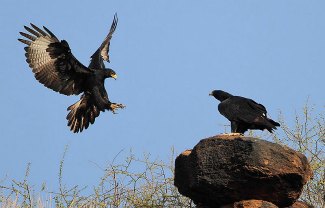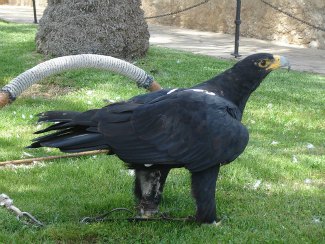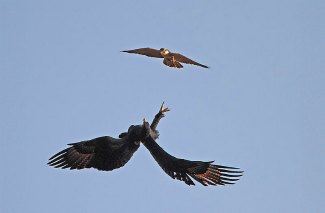Verreaux's Eagle - Aquila verreauxii
By Steve Garvie, CC-BY-NC-SA-2.0, via Wikimedia Commons/ Flickr
Family: Accipitridae
Genus: Aquila
Species: A. verreauxii
Verreaux's Eagles are medium to large raptors that live in the Arabian Peninsula and Africa. They form a clade with Aquila africana (Cassin's Hawk Eagle), A. audax (Wedge-Tailed Eagle), A. chrysaetos (Golden Eagle), A. fasciata (Bonelli's Eagle), and A. gurneyi (Gurney's Eagle).
Physical Description:
Verreaux’s Eagles are entirely black except for a white rump and two short bands of white extending along the sides of the back. There are also white patches on the primary feathers. Females are browner than males and have longer and thicker feathers on the tarsi. Eyes are dark brown and the cere, eye rings, and feet are bright yellow. The wings are built for generating lift, and because of this Verreaux's Eagles are capable of flying in winds up to 157 kph.
Juveniles are highly different from adults and have a gold crown, rufous nape, and black cheeks, along with a dark breast, cream-colored thighs and legs, and buff wing coverts. The cere, eye-rings, and feet are a duller yellow than the adults’. They reach full adult plumage after 5-6 years.
Verreaux’s Eagles are very quiet birds. Among the calls that have been recorded are clucking and chirruping, ringing "whaeee whaeee"s and "kee-oo-kee-oo"s, screams, barks, yelps, and mewing.
Size:
Length: 78-90 cm
Wingspan: 181-219 cm
Weight: Male: 3.0-4.15 kg. Female: 3.1-5.8 kg.
By Orlica, Public domain, via Wikimedia Commons
Habitat and Distribution:
They live along rocky hills, cliffs, mountains, gorges, and monadnocks (small mountains situated on surrounding flat terrain) in savannah, woodland, and sub-desert habitats, from 0-5,000+ meters above sea level.
Verreaux’s Eagles occur in the Arabian Peninsula, central Africa, and southern Africa, from 30°N to 35°S. Adults are partial migrants and juveniles disperse from their breeding areas. There are an estimated 10,000-100,000 individuals over a range of 4,030,000 km².
Diet and Hunting:
Most of their diet consists of rock hyraxes from genera Procavia and Heterohhyrax, which can weigh up to 5.4 kg. In southern Africa hyraxes constitute 60-90% of the eagles’ diet, and up to 400 may be eaten by a pair and their chick. Other prey includes francolins, guineafowl, herons, egrets, reptiles, hares, rabbits, monkeys, and even klipspringer young, which are known to weigh 12 kg. They also occasionally eat carrion.
Verreaux’s Eagles hunt by soaring and swooping to catch their prey, quartering areas for food, or by still-hunting from a tree or rock. Cooperative hunting is utilized for hunting hyraxes, where one eagle flies above to distract the hyrax colony and the other eagle attacks; they are also reported to shove hyraxes off cliffs. Most prey is taken on the ground, but some is caught in trees. Like many other eagle species, they are kleptoparasites, most often stealing food from Gypaetus barbatus (Bearded Vulture) and Polemaetus bellicosus (Martial Eagle).
Reproduction:
Breeding displays consist of circling, figure eights, claw-grappling, aerial somersaults and half-rolls, tumbling, spirals, and steep dives and swoops. The breeding season is from December-August in Sudan and the Arabian Peninsula, October-May in Ethiopia and Somalia, and April-November south of, and including, Zambia. Pairs are monogamous and may have up to five separate nest sites.
By Steve Garvie, CC-BY-NC-SA-2.0, via Wikimedia Commons/ Flickr
The nest is built out of sticks and is usually around 1.8 m across and 2.0 m deep, though one was 4.1 m in depth. Nests are reused for several years and take 6-16 weeks to build by a pair; they are lined with green leaves and placed on a cliff, beneath an overhang, in a cave, or on an open ledge. Sometimes Verreaux’s Eagles use the nest sites of other birds, such as Haliaeetus vocifer (African Fish Eagle). 1-3, usually 2 eggs are laid and incubated for 43-47 days. Predators of their eggs include mongooses, baboons, leopards, and rock pythons. The eggs are laid, and consequently hatch, 3-4 days apart, and the older chick often kills the younger, behavior known as Cainism or siblicide. Fledging takes 84-99 days.
Conservation:
They are widespread throughout their range, though they are subject to some persecution by farmers. Verreaux’s Eagles are currently listed as Least Concern by BirdLife International.
Taxonomy:
Aquila verreauxii was found to form a clade with Aquila africana (Cassin's Hawk Eagle), A. audax (Wedge-Tailed Eagle), A. chrysaetos (Golden Eagle), A. fasciata (Bonelli's Eagle), and A. gurneyi (Gurney's Eagle) based on DNA sequences of one mitochondrial and three nuclear genes.
The scientific binomial name Aquila verreauxii comes from Jules Verreaux, a naturalist who visited Africa in the early 1700s.
Other Names:
African Black Eagle, Black Eagle, Witkruisarend (Afrikaans), Orel damaní (Czech), Verreauxøs;rn (Danish), Zwarte Arend (Dutch), Mustakotka (Finnish), Aigle de Verreaux (French), Kaffernadler (German), Kafförn (Icelandic), Aquila di Verreaux (Italian), Koshijiroinuwashi (Japanese), Ngongo zonsavangi (Kwangali), Juodasis erelis (Lithuanian), Klippeøs;rn (Norwegian), Orzel czarny (Polish), Águila Cafre (Spanish), Tai Nderi (Swahili), Klippös;rn (Swedish), Ntsu (Twsana), Untsho (Xhosa).
Video of a Verreaux's Eagle:
References:
http://www.africanraptors.org/the-verreauxs-eagle-an-interview-with-dr-rob-davies/
http://avibase.bsc-eoc.org/species.jsp?avibaseid=14F13C32872CBA1C
http://www.biodiversityexplorer.org/birds/accipitridae/aquila_verreauxii.htm
BirdLife International (2012) Species factsheet:Aquila verreauxii. Downloaded from http://www.birdlife.org on 11/04/2012.
http://www.blackeagles.co.za/introduction.htm
Global Raptor Information Network. 2012. Species account: Verreaux's Eagle Aquila verreauxii. Downloaded from
http://www.globalraptors.org on 11 Apr. 2012
http://www.guardian.co.uk/science/grrlscientist/2012/jan/09/4
http://ibc.lynxeds.com/species/verreauxs-eagle-aquila-verreauxii
BirdLife International 2009. Aquila verreauxii. In: IUCN 2011. IUCN Red List of Threatened Species. Version 2011.2.
www.iucnredlist.org. Downloaded on 11 April 2012.
http://lifedesk.bibalex.org/ba/pages/937
http://www.planetofbirds.com/accipitriformes-accipitridae-verreauxs-eagle-aquila-verreauxii
Ferguson-Lees, James, and Christie, David A. Raptors of the World. Houghton Mifflin Company, 2001.


